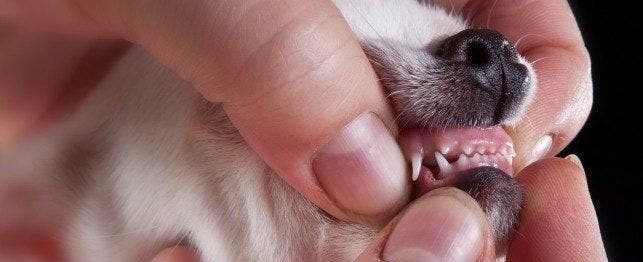
Understanding Teething in Puppies
What is Teething in Puppies?
Teething is a term that refers to the process of permanent teeth coming in to your puppies’ mouth. Permanent teeth will replace the baby teeth.
Tell me More About Puppy Teeth
The teeth are located on both sides of the mouth with two rows of upper teeth that are anchored in the maxilla bone of the face. Two rows of lower teeth are anchored in the jaw bones (mandibular bone).
Dogs generally have 28 baby teeth, also referred to as deciduous teeth, and 42 adult or permanent teeth.
When Does Puppy Teething Typically Start?
Puppies, like human babies, are born without teeth. Only the gum surface is visible. This allows them to nurse without hurting the mother.
There are two stages to teething. The first is when the puppy gets in his baby teeth and the second is when the baby teeth fall out and your puppy gets his adult teeth. Things happen quickly in puppies as compared to humans.
When a puppy reaches 21 to 30 days of age, their deciduous or temporary (baby) teeth start to break through the gums. This is referred to as “erupting.” The exact age for this will differ amongst breeds and can even vary within puppies of the same litter.
Puppies have a total of 28 deciduous teeth by the time they reach 45 days of age (just over 6 weeks of age). The first teeth to break through are the incisors which are at the top front of the upper and lower jaws. These can begin as early as 14 – 21 days but often are closer to 30 days. After this – the needle like canine teeth (often called the fang teeth) appear between days 30 and 45. The teeth behind them in the back of the mouth are the premolars and molars and come in between days 21 and 45.
The second phase of teething is when the adult teeth start coming in, which generally starts around 8 weeks of age, and most breeds show permanent teeth at 6 to 7 months of age.
Teething is often worst between 12 and 20 weeks of age.
When Do Adult Teeth Start to Come in?
The permanent teeth include six pairs of sharp incisor teeth, which are in the front of the mouth, surrounded by two pairs of large canine teeth. The premolar teeth are located just behind the canine teeth. The molars sit behind the premolars and are towards the back of the mouth.
Eruption of the permanent teeth is as follows:
Incisors
- Central: 2-5 months
- Intermediate: 2-5 months
- Corner: 4-5 months
Canines
- 5 months
Premolars
- First: 4-5 months
- Second: 6 months
- Third: 6 months
- Fourth: 4-5 months
Molars
- First: 5-6 months
- Second: 6-7 months
- Third: 6-7 months
What are Signs of Teething?
Some puppies are more bothered by teething than others. This may be because of soreness and swelling in the gums before a tooth comes through.
Symptoms associated with teething usually begin about 1 to 3 days before the tooth shows, and signs generally disappear as soon as the tooth breaks the skin. Many puppies don’t seem to be affected by teething at all.
Puppies often chew to help relieve the pressure in their gums. In rare cases, puppies may be reluctant to eat and drink because their mouths hurt.
How Can You Help Your Puppy While Teething?
Teething is worst between 12 and 20 weeks of age but is noticed by most puppy owners around 8 weeks which is a common time to acquire a new puppy. By the time your puppy is about 6 months old, they will have all their adult teeth. Here are some tips to help your puppy feel better while teething:
- Provide safe chew toys. Toys ideal to use during teething should be durable (can’t be chewed and swallowed) but are soft in texture so they don’t damage the teeth coming in.
- Plush toys are great but have the risk of being shredded and eaten causing a life-threatening foreign body, so they are not recommended.
- Some treats can be frozen which can soothe inflamed gums while chewing.
- Puzzle toys are often great ways to keep your puppy busy and occupied (and keep their mind off their teething). Examples of good puzzle toys include the Kong products and Buster Cube. You can often fill these toys with treats such as a kibble of food, soft food, or peanut butter. Many puppies will spend minutes to hours trying to get the treat out.
- Rawhide type chews are popular but can be dangerous as large chucks are chewed and eaten. Rawhides are not recommended as chew toys.
- Encourage exercise. Keep your puppy active and busy so they aren’t just focused on their mouths. Encourage them to run and play such as fetch. Take a walk. Do some training such as teaching your dog to sit, stay, roll-over.
- Rotate toys. Puppies can be bored by playing with the same toy day after day. Rotate toys after you notice your puppy isn’t playing with it like he used to then rotate it back in when he or she is bored again. Or if the toy is a puzzle toy – refill it with a treat.
Puppies generally don’t need teething remedies, such as gels which are commonly used in human babies. Do not give any medications without first checking with your veterinarian.